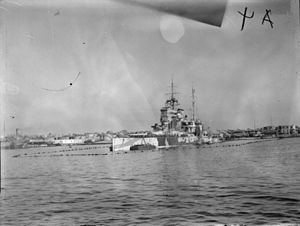Spartaco Schergat

Spartaco Schergat (1920 in Koper – 1996 in Trieste) was an Italian military frogman during World War II.[1]
Biography
This section includes a list of general references, but it lacks sufficient corresponding inline citations. (December 2020) |
Schergat was born in Istria to an Italian irredentist. He voluntarily joined the Regia Marina in 1940. He was friends with Luigi Durand de la Penne, who enrolled him in the elite Decima MAS (XMAS).
In 1941, during the Raid on Alexandria, Schergat severely damaged the British battleship Queen Elizabeth, with a human torpedo. For this military action, he received the Italian gold medal in the Second World War.[2]
From 1943 until the end of the war, Schergat collaborated with the Allies, via the Royal Navy of the Badoglio government in southern Italy.
In the 1950s, Schergat was elected as deputy of MSI, an Italian far-right party.
In 1996 Spartaco Schergat died, after a long struggle with cancer, in Trieste.[3]
The attack on Queen Elizabeth
As part of a team of divers of the X MAS he took part in the human torpedo attacks on British vessels in the Mediterranean. In December 1941, Schergat was one of a team of six (Luigi Durand de la Penne with Emilio Bianchi; Antonio Marceglia with Spartaco Schergat; Vincenzo Martellotta with Mario Marino) which attacked Alexandria harbour. They used the new Italian secret torpedo S.L.C. ("Siluro Lenta Corsa", also known as "maiale"), a small underwater assault vehicle with a crew of two. As a result, four ships were damaged in Alexandria: the British battleships Queen Elizabeth (by Marceglia and Schergat) and Valiant (by Martellotta and Marino), and the tanker Sagona[4] with the destroyer Jervis.[5] Spartaco Schergat personally placed the limpet mine under the hull of Queen Elizabeth.
However, the two capital ships were in shallow water, Queen Elizabeth settling on the sea bed, Valiant down by the bow, but both maintained the illusion from the air that they were undamaged. Temporary repairs were quickly effected; Queen Elizabeth was sent to the United States for permanent full repairs, Valiant to Durban, South Africa. Both ships were out of action for over one year.[6]
This represented a dramatic change of fortunes against the Allies from the strategic point of view in the central Mediterranean Sea during the next half-year or more. The Italian fleet - with the Alexandria Raid - had nominally achieved naval supremacy in the Mediterranean Sea, called in that year Italy's Mare Nostrum by fascist propaganda.[7]
See also
References
- ^ Photo of Spartaco Schergat
- ^ "Article in Italian about the sinking of the battleship Queen Elizabeth" (PDF). Archived from the original (PDF) on 7 May 2006.
- ^ "MORTO IL MARINAIO CHE AFFONDO' LA QUEEN ELISABETH - la Repubblica.it". Archivio - la Repubblica.it. 27 March 1996.
- ^ "M/T Sagona - Norwegian Merchant Fleet 1939-1945". www.warsailors.com.
- ^ "HMS Jervis, destroyer".
- ^ "...the battleships Queen Elizabeth and Valiant, so badly damaged that they were effectively out of service for the duration of the Italian war effort." Sadkovich, page 334
- ^ "Consequently, the Alexandria Fleet remained for many months without any battleships, and it was forced to abandon any further open activity. In fact, Admiral Cunningham wrote that his Fleet now should have to leave it to the Royal Air Force to try if they could dispute the control of the Central Mediterranean with the enemy's fleet.(...) In fact, it opened a period of clear Italian naval supremacy in the east-central Mediterranean." Bragadin, page 152
Bibliography
- "Frogmen First Battles" by retired U.S. Captain William Schofield's book. ISBN 0-8283-2088-8
- The Italian Navy in World War II by Marc'Antonio Bragadin, United States Naval Institute, Annapolis, 1957. ISBN 0-405-13031-7
- The Italian Navy during World War II by Sadkovich, James, Greenwood Press, Westport, 1994. ISBN 0-313-28797-X

